The research interests of the group are focused on multi-wavelength observations and theoretical modelling of accreting sources, galaxies, supernova remnants, and the Ionised Intergalactic Medium.
We use data obtained with a wide suite of space observatories observing in X-ray, Ultraviolet, Optical and Infrared wavelengths. In addition we use data from ground-based optical and infrared facilities such as the Skinakas Observatory. The goal of these observations is: to understand the physical processes which produce the observed radiation, study the evolution of stellar systems and galaxies, and probe the baryonic content of the Universe.
The theoretical efforts of our group are focused on the radiation production mechanisms in accreting sources, the interaction between radiation and matter and the structure of galaxies.
Annual Reports:
A detailed description of the activities of the Group during 2018 can be found in our 2018 Annual report. Previous annual reports can be found here.
Some science highlights from our group include:
The Turbulent Assembly of Hot DOGs
Super-massive black holes (SMBHs), that is black holes with at least one million times the mass of the Sun, are typically found at the center of galaxies. While black holes are, by definition, the darkest regions of the Universe as light cannot escape their gravity, they can paradoxically also be the most luminous. When SMBHs grow, the gas that is feeding them forms an accretion disk before crossing the event horizon that can become so bright as to outshine all the stars in a galaxy together. These luminous growing SMBHs are called "quasars", and can be found across the Universe in a range of luminosities.
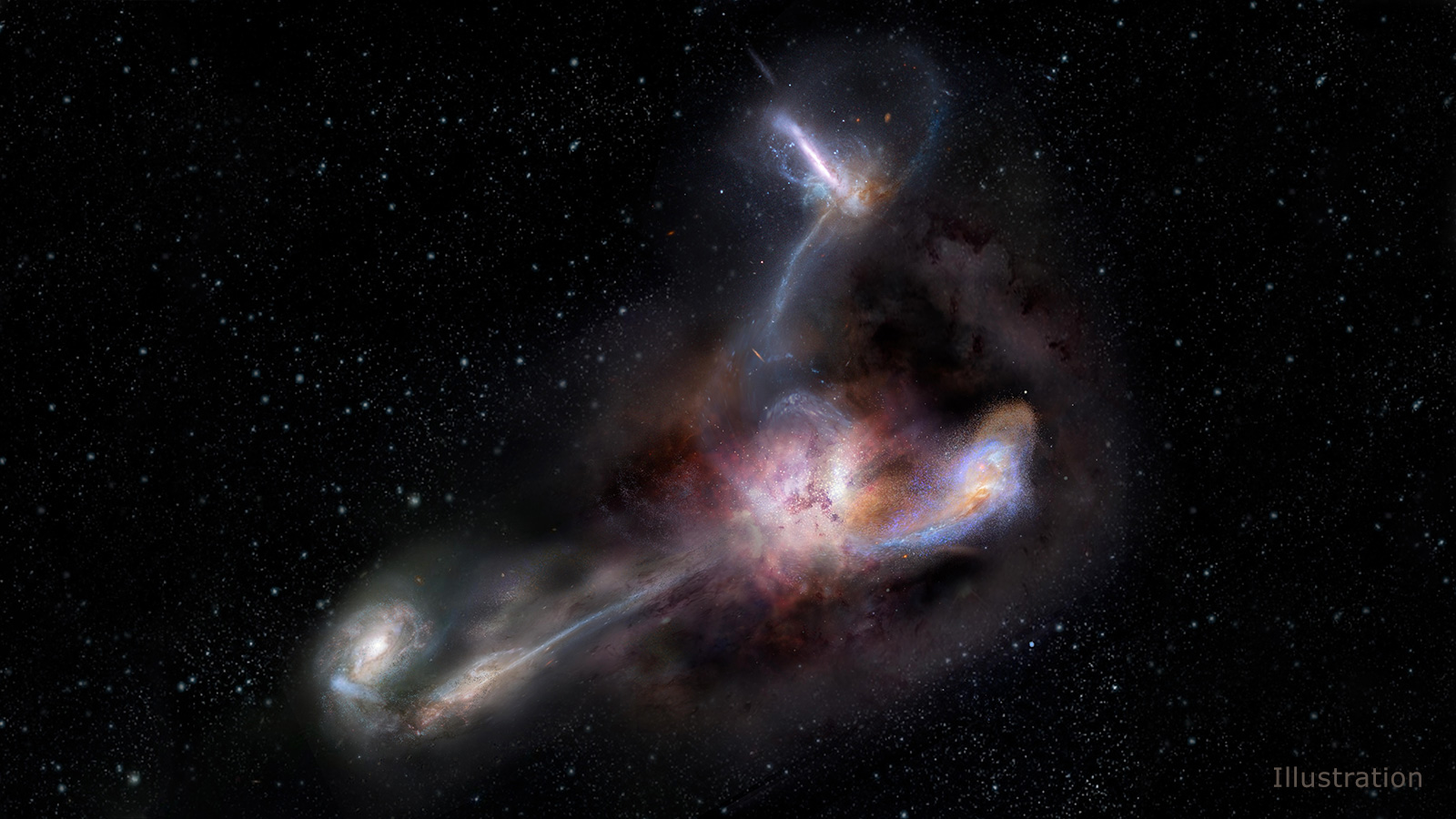
Extremely luminous, hot, dust-obscured galaxies (EL Hot DOGs) are some of the most luminous quasars discovered to date. These objects, which shine with the intensity of more than 100 trillion Suns, lived at a time when the Universe was less than one seventh of its current age. A group of astronomers led by Tanio Díaz-Santos, a researcher at the Institute of Astrophysics at FORTH in Crete, used the Atacama Large Sub/millimeter Array (ALMA) to image a small sample of 7 EL Hot DOGs in the far-infrared spectrum of light in order to study the distribution of gas and dust near the SMBHs as well as in their host galaxies. These observations have allowed them to acquire critical information about the gas dynamics and the physical properties of their interstellar medium.
In a recent study, the investigators have discovered that the random motions of the ionized gas in EL Hot DOGs are consistently very large, which indicates the interstellar medium is very turbulent -- something that can be likely explained by the infall of companion satellite galaxies and the energetic feedback from their central SMBHs. However, the morphology and rotation of the gas is not uniform among the EL Hot DOG population, as it usually is in obscured quasars found in the local Universe. This lack of uniformity in the gas and dust properties have led the investigators to think that the EL Hot DOG phase may be recurrent in the life of the most massive galaxies living at the knots of the cosmic web in the early Universe. This would be in contrast with the current paradigm of the formation of quasars in the nearby Universe, where this phase is believed to happen only once, as a consequence of the merging of two massive spiral galaxies. While these results are tantalizing, more observations are needed to confirm the difference in the origin and evolution between near and far obscured quasars.
Article:“Kinematics and star formation of high-redshift hot dust-obscured quasars as seen by ALMA”, T. Diaz Santos et al., 2021, A&A, 654, 37 – October 2021
Modelling the UV/optical continuum time-lags in AGN
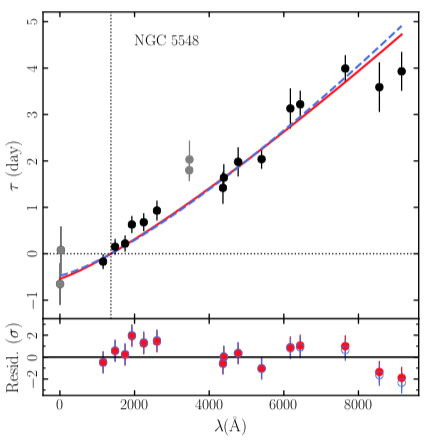
A group of astronomers, including Prof. Iossif Papadakis of the Institute of Astrophysics and the Department of Physics of the University of Crete have recently explained the correlated optical/Ultraviolet(UV) variations that are observed in Active Galactic Nuclei (AGN).
Approximately 10 per cent of nearby galaxies host active nuclei, which emit enormous amount of light (equivalent to the light of the whole galaxy) from regions which are not much larger than our Solar system. AGN are the most powerful, persistent objects in the Universe. We currently believe that their enormous luminosity is powered by the accretion of gas to supermassive black holes which reside at their center (their mass being million to billion times larger than the mass of our Sun). The gas forms a disc, which is very small in size and cannot be resolved by any telescope on Earth. We are therefore forced to test our theory via other means, like the variations we observed in the optical and UV bands.
So far, the results appeared to suggest that the discs must be significantly larger than what the theory would suggest. This discrepancy was one of the most serious problems regarding our understanding of the power mechanism in AGN.
Recently, Prof Papadakis and his collaborators studied the response of an accretion disc in the case when it is illuminated by an intense X-ray source, taking into account all the general and special relativistic effects, as well as the important atomic physics effects which determine the amount of X-rays that the disc will absorb. They modeled the expected variations and delays between them (in the optical/UV band) and they showed that, despite previous claims, the observations are fully consistent with the standard accretion disc models. In addition to provide an explanation for the apparent discrepancies between observations and our theoretical models, the results from this work have also important implications regarding the physical processes, the spin of the supermassive black holes and the geometry between the X-ray source and the accretion discs in these enigmatic systems
Article: “Modelling the UV/optical continuum time-lags in AGN”, Kammoun E., Papadakis I. E., & Dovciak, M. 2021, MNRAS, 503, 4163 – October 2021
A new method to infer the magnetic field of the interstellar medium achieves unprecedented accuracy
A large-scale magnetic field (ranging from a fraction of a μG to hundreds of mG) permeates the interstellar medium (ISM) of our Galaxy and is involved in a variety of astrophysical properties (e.g. star formation, cosmic ray propagation). Characterizing the magnetic field properties is necessary in order to understand these processes.
Dust polarization has been proven one of the most powerful observables for studying the field properties in the ISM, although it probes only the magnetic field orientation and not its strength. For this reason, various methods which infer the magnetic field strength have been developed. The most widely applied method has been developed by Davis (1951) and Chandrasekhar & Fermi (1953) (DCF). This method relies on the assumption that the observed spread in the distribution of polarization angles is due to the propagation of the so-called Alfvén magnetohydrodynamic waves. Observations, however, indicate that non-Alfvénic (compressible) modes may be important in the ISM dynamics.
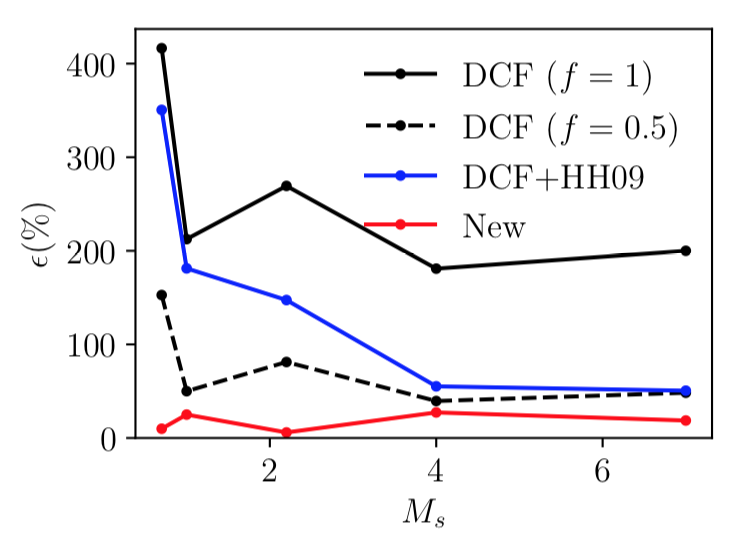
Rafael Skalidis, a PhD student at the Institute of Astrophysics and his supervisor Prof. Kostantinos Tassis propose a new method for estimating the magnetic field strength which includes the compressible modes. They have tested their method in MHD numerical simulations and compared it with the classical DCF method.
In the figure to the right it is shown with the black solid line (f=1) the relative deviation of the DCF estimated magnetic field strength from the true value in five different MHD simulation models. The black dotted line shows the DCF estimates corrected for line of sight and turbulent effects (f=0.5). Τhe blue line corresponds to DCF combined with the method of Hildebrand et al. 2009 and Houde et al. 2009, which corrects for line of sight and instrumental effects. The red line corresponds to the relative deviation of the true magnetic field strength and the value obtained with our method. The proposed method outperforms the previous methods, which are based solely on Alfvénic modes, and achieves a mean relative deviation of 17% without the need for a correction.
Article:“High-accuracy estimation of magnetic field strength in the interstellar medium from dust polarization”, R. Skalidis, K. Tassis, 2021, A&A, 647, 186 – March 2021 - A follow up study by R. Skalidis, et al. 2021, A&A, 656, A118 was highlighted by A&A.
The source of hard X-rays in black hole binaries
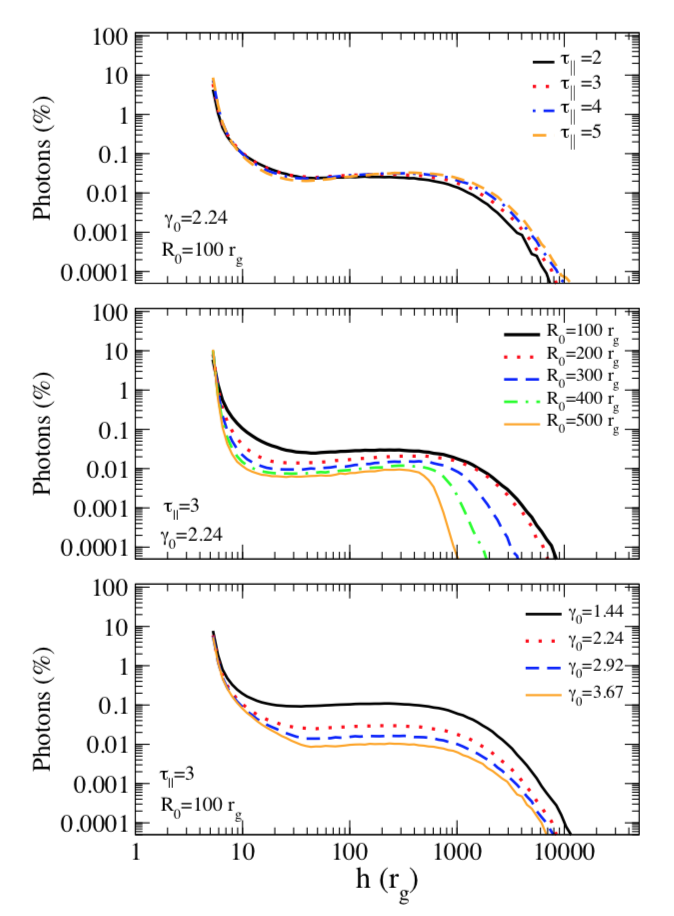
The models that seek to explain the reflection spectrum in black hole binaries usually invoke a point-like primary source of hard X-rays. This source illuminates the accretion disk and gives rise to the discrete (lines) and continuum-reflected components. Because of the complexity of the physics involved, many authors consider a simple geometry in which the illuminating continuum is assumed to be emitted isotropically from a point source on the rotational axis at certain height above the black hole. This model is known as the lamp post model. However, the lamp post model is an idealized case of the real physical source, which is likely extended, variable, and highly anisotropic.
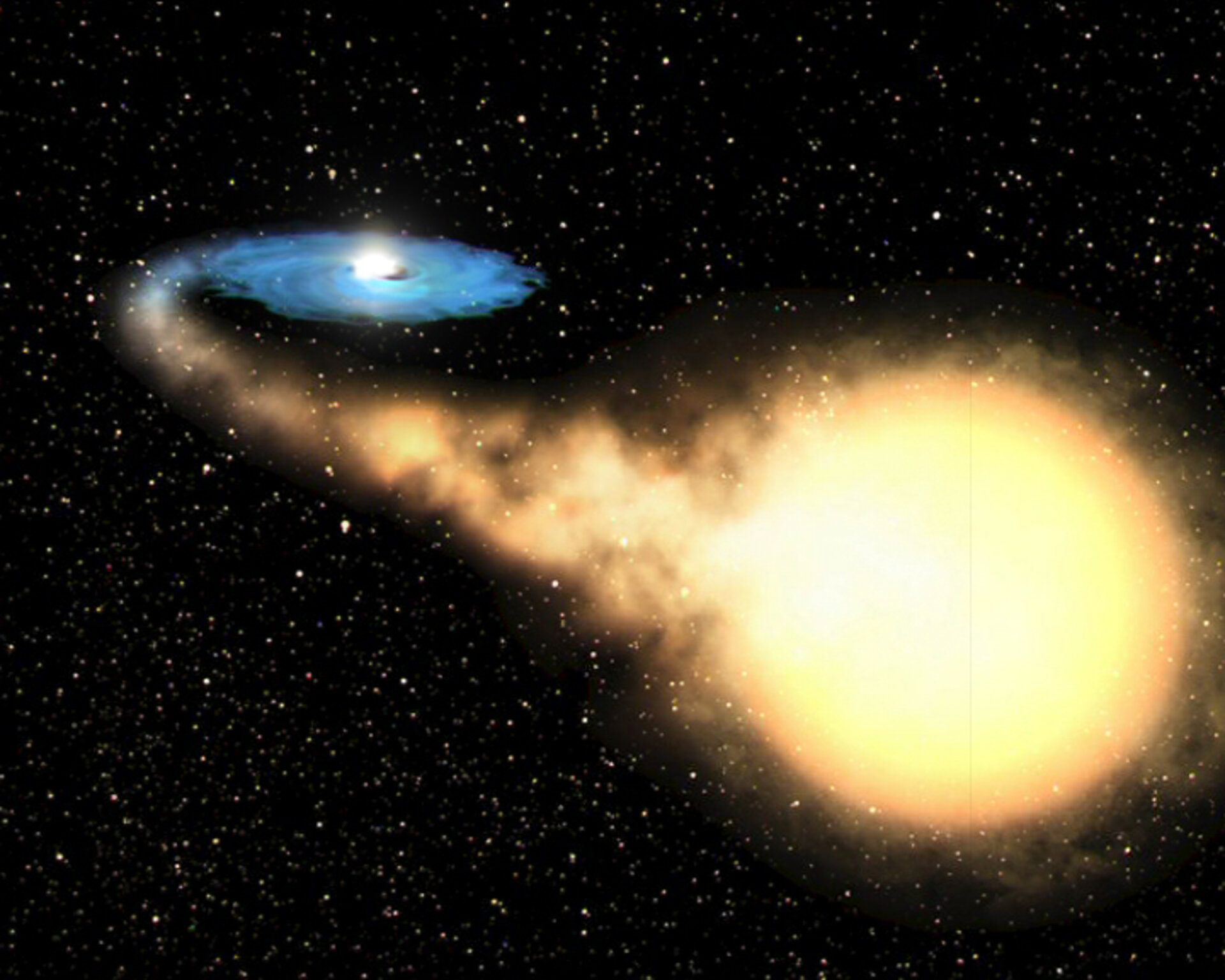
Constraining the nature and geometry of the source of the hard X-rays that illuminates the disk is of paramount importance because it will allow us to consider more realistic models. It is well-stablished that black holes in binary systems emit powerful jets of matter at relativistic velocities (see figure). Researchers P. Reig and N. Kylafis of the Institute of Astrophysics and University of Crete have recently demonstrated that the jet itself can be indeed the disk-illuminating source.
Using complex numerical methods, they found that, regardless of the optical depth, jet width, and jet velocity, a significant fraction of the Comptonized photons are back-scattered and hit the disk. The majority of photons that hit the disk escape within a few gravitational radii, as expected in the lamp post model. More importantly, there is a significant contribution of photons that escape at larger radii (see figure to the left.).
Article: “Illumination of the accretion disk in black hole binaries: An extended jet as the primary source of hard X-rays”, Reig, P. & Kylafis, N. D. , 2021, A&A, 646, A112 - February 2021
The Musca molecular cloud: An interstellar symphony
Dr. Aris Tritsis and Prof. Konstantinos Tassis of the Department of Physics of the University of Crete have reported the first-ever discovery of normal modes in a molecular cloud, called Musca. This discovery has allowed the two researchers to precisely determine the physical dimensions of the cloud.
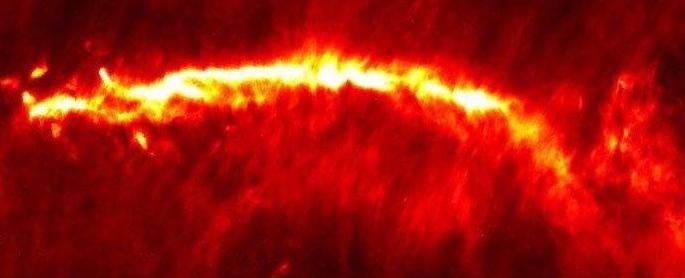
Molecular clouds can only be seen as two-dimensional projections on the plane of the sky with no way of knowing their true shapes. This is a fundamental constraint for studies of the interstellar medium, since the 3-dimensional (3D) structure of clouds encodes critical information regarding the physical processes that control the formation of stars and planets. Therefore, the determination of the 3D shape of clouds has been aggressively pursued through primarily statistical studies which however, have yielded contradictory results and do not provide information on a cloud-by-cloud basis.
Musca is an isolated cloud seen from the Southern hemisphere and it is one of the most ordered molecular clouds observed. The main dense structure of Musca, inside which stars will eventually form, is surrounded by hair-like structures called striations. In a previous study, also by Aris Tritsis and Konstantinos Tassis (Tritsis & Tassis 2016, MNRAS, 462, 3602), it was found that the only viable mechanism that could account for the formation of striations was through the excitation of magnetic pressure waves. However, in the case of the isolated Musca, the waves creating striations were trapped setting up normal modes.
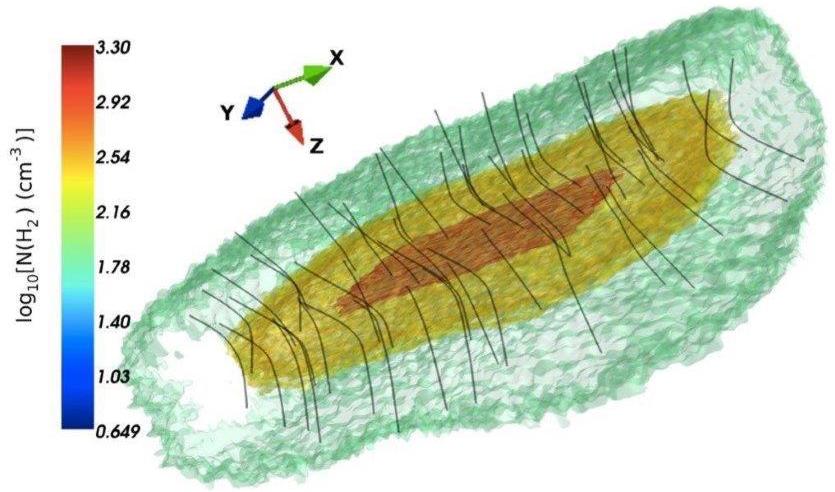
Because of its needle-like appearance on the plane of the sky, Musca was considered to be the poster-child of an interstellar filament against which many theoretical models were put to the test. However, in contradiction to conventional wisdom the normal-mode analysis of striations has shown that Musca is in fact a sheet seen edge-on.
A video presenting a summary of the results of the paper is available here.
Musca is the first cloud found to be oscillating as a whole, and the largest structure in the Galaxy to which a normal-mode analysis has been successfully applied to date.
Article: “Magnetic Seismology of Interstellar Gas Clouds: Unveiling a Hidden Dimension", A. Tritsis, K. Tassis, Science 360, 6389, pp.635-638 (2018).
Warped disks during giant outbursts in Be/X-ray binaries: evidence from optical polarimetry
Drs Pablo Reig and Dmitry Blinov of the Institute of Astrophysics have found the first evidence of precessing warped disks from polarimetric observations of the Be/X-ray binary 4U 0115+65.
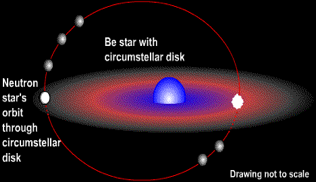
Be/X-ray binaries are accreting pulsars, in which a neutron star orbits a Be star. The neutron star accretes matter from its companion and generates hard X-rays. When, active these systems are among the brightest in the X-ray sky, with peak luminosities of LX~1038 erg/s during outbursts. The source of matter available for accretion is the circumstellar disk around the B star's equator. Although there is general consensus that the outbursts are caused by the mass transfer from the Be disk to the neutron star, the detailed mechanism is uncertain. In particular, it is still a matter of debate how the Be disk links to the X-ray activity. We observe giant X-ray outbursts in systems with large and small disks. Likewise, systems with large disk show no X-ray activity.
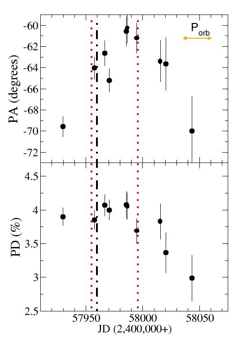
The current idea is that the giant outbursts occur when the neutron star captures a large amount of gas from a warped, highly misaligned and eccentric Be disk. The models show that highly distorted disks result in enhanced mass accretion when the NS gets across the warped part.
We have found the first observational evidence for warped disks during an X-ray outburst using polarimetry. The light coming from the Be star is linearly polarized. Linear polarization results from Thomson scattering, when photons from the Be star scatter with electrons in the Be disk. The light becomes polarized perpendicularly to the scattering plane, which roughly coincides with the plane of the circumstellar disk. The polarization angle then gives information about the orientation of the disk. Therefore, if X-ray outbursts In Be/X-ray binaries require tilted, misaligned, warped eccentric disks that precess, then the polarization angle should change.
The illustration to the left shows the variation of the polarization angle and polarization degree with time during the course of an outburst. The data were obtained using the RoboPol polarimeter at the 1.3-m telescope of the Skinakas Observatory.
We interpret this variability as evidence for a warped precessing disk, supporting models that predict highly perturbed disks as the origin of giant outbursts in BeXB.
Article: Warped disks during type II outbursts in Be/X-ray binaries: evidence from optical polarimetry, Reig P. & Blinov D. 2018, A&A 619, A19
Cosmic Magnifying Lens Reveals Inner Jets of Black Holes
An international team of astronomers, including Prof. Vasiliki Pavlidou of the Institute of Astrophysics and the Department of Physics of the University of Crete have discovered a unique lensing system in space, in which a 10,000-solar-mass lens is magnifying a much more distant galaxy containing a jet-spewing supermassive black hole. The discovery provides the best view yet of blobs of hot gas that are shot outward from supermassive black holes.
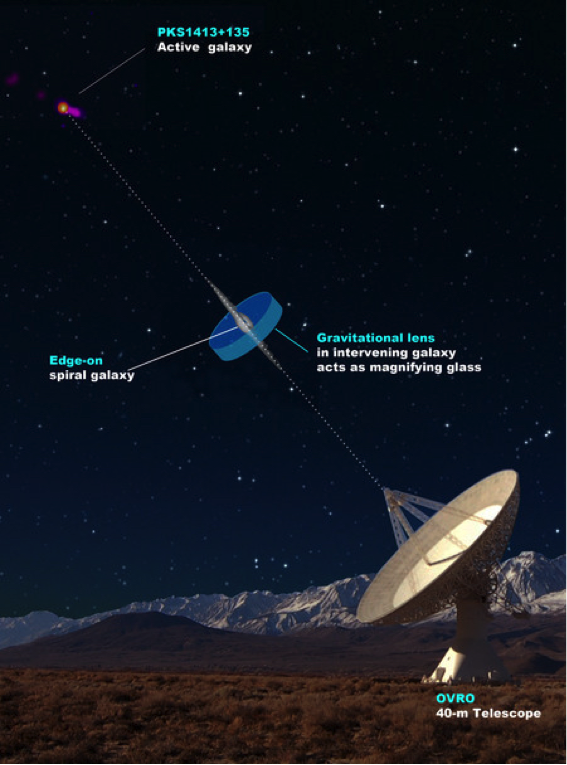
Many supermassive black holes at the centers of galaxies blast out jets of gas traveling near the speed of light. The gravity of black holes pulls material toward them, but some of that material ends up ejected away from the black hole in jets. The jets are active for one to 10 million years—every few years, they spit out additional clumps of hot material. With the new gravitational lensing system, these clumps can be seen at scales about 100 times smaller than before – with a resolution of a millionth of a second of arc, which is equivalent to viewing a grain of salt on the moon from Earth.
A critical element of this lensing system is the lens itself. If confirmed, this would be the first lens of "intermediate" mass—which means that it is bigger than previously observed "micro" lenses consisting of single stars and smaller than the well-studied massive lenses as big as galaxies. The lens, dubbed a "milli-lens," is thought to be about 10,000 solar masses. It is likely a cluster of stars, but it could also be a dark-matter agglomerate.
An advantage of the milli-sized lens is that it is small enough not to block the entire source, which allows the jet clumps to be magnified and viewed as they travel, one by one, behind the lens. What's more, the lens itself is of scientific interest because not much is known about objects of this intermediate-mass range.
The new observations are part of Caltech's Owens Valley Radio Observatory (OVRO) program to obtain twice-weekly images of 1,800 active supermassive black holes and their host galaxies, using OVRO's 40-meter telescope, which detects radio emissions from celestial objects. The program has been running since 2008 in support of NASA's Fermi mission, which observes the same galaxies in higher-energy gamma rays.
In 2010, the OVRO researchers noticed something unusual happening with an active galaxy called PKS 1413+ 135. Its radio emission had brightened, faded, and then brightened again in a very symmetrical fashion over the course of a year. The same type of event happened again in 2015. After a careful analysis that ruled out other scenarios, the researchers concluded that the overall brightening of the galaxy is most likely due to two successive high-speed clumps ejected by the galaxy's black hole a few years apart. The clumps traveled along the jet and became magnified when they passed behind the milli-lens.
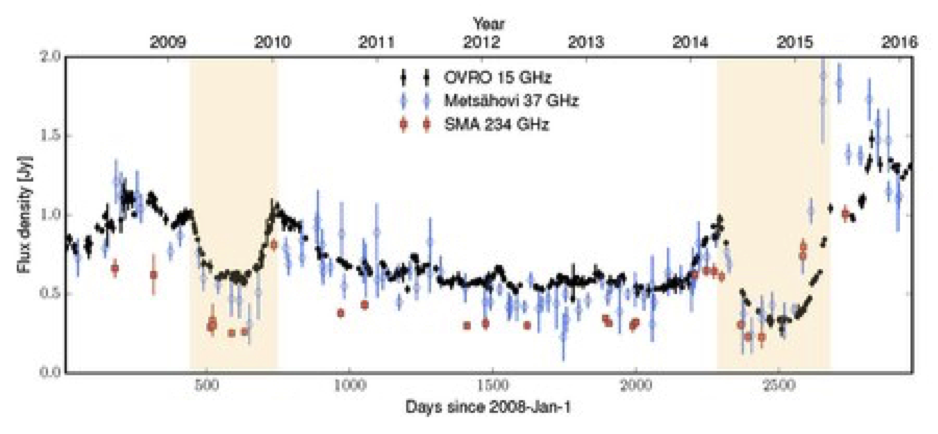
The international research team was led by Anthony Readhead (emeritus Professor at Caltech and a collaborator on many University of Crete key projects, including RoboPol and PASIPHAE, and it included Institute of Astrophysics affiliated researcher Vasiliki Pavlidou, who has been a member of the OVRO collaboration since 2008.
Other collaborators of this work include Harish Vedantham (the lead author), Timothy Pearson and Vikram Ravi of Caltech, Walter Max-Moerbeck and Anton Zensus of the Max Planck Institute for Radio Astronomy; Talvikki Hovatta of University of Turku and the Aalto University Metsähovi Radio Observatory; Anne Lähteenmäki and Merja Tornikoski of the Aalto University Metsähovi Radio Observatory; Mark Gurwell of the Smithsonian Astrophysical Observatory; Roger Blandford of Stanford University; and Rodrigo Reeves of the University of Concepción.
More information is also available in the original Caltech Press Release.
Articles: “Symmetric Achromatic Variability in Active Galaxies: A Powerful New Gravitational Lensing Probe?” by Vedantham et al. 2017, The Astrophysical Journal, 845, 89, and "The Peculiar Light Curve of J1415 + 1320: A Case Study in Extreme Scattering Events" by Vedantham et al. 2017, The Astrophysical Journal, 845, 90
